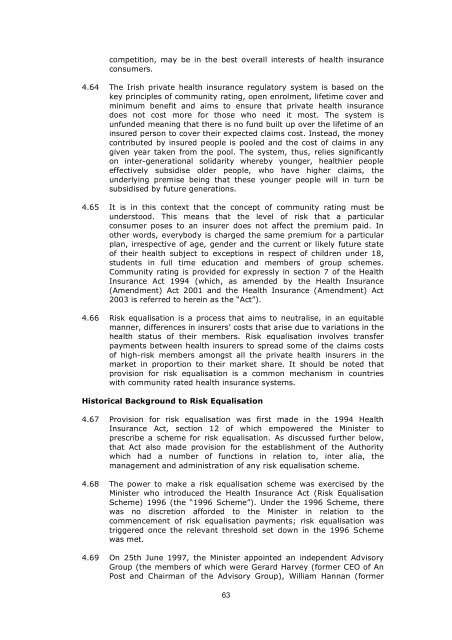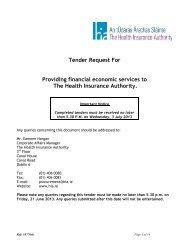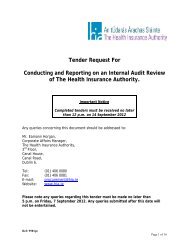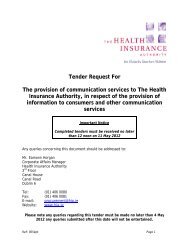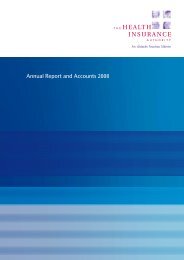Competition in the Irish Private Health Insurance Market
Competition in the Irish Private Health Insurance Market
Competition in the Irish Private Health Insurance Market
You also want an ePaper? Increase the reach of your titles
YUMPU automatically turns print PDFs into web optimized ePapers that Google loves.
competition, may be <strong>in</strong> <strong>the</strong> best overall <strong>in</strong>terests of health <strong>in</strong>surance<br />
consumers.<br />
4.64 The <strong>Irish</strong> private health <strong>in</strong>surance regulatory system is based on <strong>the</strong><br />
key pr<strong>in</strong>ciples of community rat<strong>in</strong>g, open enrolment, lifetime cover and<br />
m<strong>in</strong>imum benefit and aims to ensure that private health <strong>in</strong>surance<br />
does not cost more for those who need it most. The system is<br />
unfunded mean<strong>in</strong>g that <strong>the</strong>re is no fund built up over <strong>the</strong> lifetime of an<br />
<strong>in</strong>sured person to cover <strong>the</strong>ir expected claims cost. Instead, <strong>the</strong> money<br />
contributed by <strong>in</strong>sured people is pooled and <strong>the</strong> cost of claims <strong>in</strong> any<br />
given year taken from <strong>the</strong> pool. The system, thus, relies significantly<br />
on <strong>in</strong>ter-generational solidarity whereby younger, healthier people<br />
effectively subsidise older people, who have higher claims, <strong>the</strong><br />
underly<strong>in</strong>g premise be<strong>in</strong>g that <strong>the</strong>se younger people will <strong>in</strong> turn be<br />
subsidised by future generations.<br />
4.65 It is <strong>in</strong> this context that <strong>the</strong> concept of community rat<strong>in</strong>g must be<br />
understood. This means that <strong>the</strong> level of risk that a particular<br />
consumer poses to an <strong>in</strong>surer does not affect <strong>the</strong> premium paid. In<br />
o<strong>the</strong>r words, everybody is charged <strong>the</strong> same premium for a particular<br />
plan, irrespective of age, gender and <strong>the</strong> current or likely future state<br />
of <strong>the</strong>ir health subject to exceptions <strong>in</strong> respect of children under 18,<br />
students <strong>in</strong> full time education and members of group schemes.<br />
Community rat<strong>in</strong>g is provided for expressly <strong>in</strong> section 7 of <strong>the</strong> <strong>Health</strong><br />
<strong>Insurance</strong> Act 1994 (which, as amended by <strong>the</strong> <strong>Health</strong> <strong>Insurance</strong><br />
(Amendment) Act 2001 and <strong>the</strong> <strong>Health</strong> <strong>Insurance</strong> (Amendment) Act<br />
2003 is referred to here<strong>in</strong> as <strong>the</strong> “Act”).<br />
4.66 Risk equalisation is a process that aims to neutralise, <strong>in</strong> an equitable<br />
manner, differences <strong>in</strong> <strong>in</strong>surers’ costs that arise due to variations <strong>in</strong> <strong>the</strong><br />
health status of <strong>the</strong>ir members. Risk equalisation <strong>in</strong>volves transfer<br />
payments between health <strong>in</strong>surers to spread some of <strong>the</strong> claims costs<br />
of high-risk members amongst all <strong>the</strong> private health <strong>in</strong>surers <strong>in</strong> <strong>the</strong><br />
market <strong>in</strong> proportion to <strong>the</strong>ir market share. It should be noted that<br />
provision for risk equalisation is a common mechanism <strong>in</strong> countries<br />
with community rated health <strong>in</strong>surance systems.<br />
Historical Background to Risk Equalisation<br />
4.67 Provision for risk equalisation was first made <strong>in</strong> <strong>the</strong> 1994 <strong>Health</strong><br />
<strong>Insurance</strong> Act, section 12 of which empowered <strong>the</strong> M<strong>in</strong>ister to<br />
prescribe a scheme for risk equalisation. As discussed fur<strong>the</strong>r below,<br />
that Act also made provision for <strong>the</strong> establishment of <strong>the</strong> Authority<br />
which had a number of functions <strong>in</strong> relation to, <strong>in</strong>ter alia, <strong>the</strong><br />
management and adm<strong>in</strong>istration of any risk equalisation scheme.<br />
4.68 The power to make a risk equalisation scheme was exercised by <strong>the</strong><br />
M<strong>in</strong>ister who <strong>in</strong>troduced <strong>the</strong> <strong>Health</strong> <strong>Insurance</strong> Act (Risk Equalisation<br />
Scheme) 1996 (<strong>the</strong> “1996 Scheme”). Under <strong>the</strong> 1996 Scheme, <strong>the</strong>re<br />
was no discretion afforded to <strong>the</strong> M<strong>in</strong>ister <strong>in</strong> relation to <strong>the</strong><br />
commencement of risk equalisation payments; risk equalisation was<br />
triggered once <strong>the</strong> relevant threshold set down <strong>in</strong> <strong>the</strong> 1996 Scheme<br />
was met.<br />
4.69 On 25th June 1997, <strong>the</strong> M<strong>in</strong>ister appo<strong>in</strong>ted an <strong>in</strong>dependent Advisory<br />
Group (<strong>the</strong> members of which were Gerard Harvey (former CEO of An<br />
Post and Chairman of <strong>the</strong> Advisory Group), William Hannan (former<br />
63


